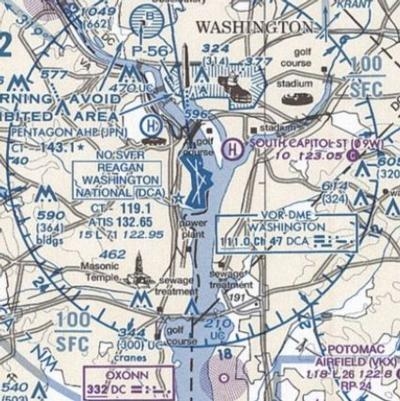Fri, Aug 03, 2012
Traffic Pattern Change Forced By Wind Shift Not Properly Communicated
The FAA is investigating a miscommunication between Warrenton Center, ATC at DCA, and the pilots of three US Airways jets that resulted in a near-collision just south of the city.

According to The Washington Post, a developing weather system caused a rapid wind change in the region, and controllers at Warrenton center determined that the traffic needed to be reversed to make the northern approach to DCA over the Potomac River.
While the change was transmitted to the DCA tower, it apparently did not make its way to the front-line controllers working the airplanes. Two aircraft were reportedly cleared to depart into the path of a third airliner which was cleared to land and on final approach to DCA from the south over Mt. Vernon, VA.
According to the paper, the planes were within 12 seconds of impact when the controller instructed the inbound flight to make an abrupt turn to avoid the departing aircraft. Transcripts of communications between ATC and that pilot indicated that the pilot was low on fuel when asked to vector around and make another approach. "We really don't have enough fuel for this," the pilot said. "We have to get on the ground pretty quick."
In a statement, the agency said it is is investigating the incident that took place just after 2 p.m. on Tuesday, July 31, 2012, when the Potomac TRACON initiated a change in the traffic flow at Reagan National Airport (DCA) due to bad weather developing south of the airport.
“At no point were the three aircraft on a head-to-head course. They were not on a collision course,” said Acting FAA Administrator Huerta. “The two departing aircraft came within these margins in relation to a plane that was landing. But, at no point were any of the planes headed directly for one another.”
DCA had been landing and departing aircraft on Runway 1, from the south to the north. Due to the bad weather developing, the TRACON was reversing operations at the airport to land and depart aircraft from the north to the south on Runway 19. During the switchover of operations, there was a miscommunication between a manager at the TRACON and two traffic management coordinators at the DCA tower. The miscommunication should not have happened. FAA safety officials are investigating why the miscommunication occurred and will take action as appropriate.
The miscommunication led to a loss of the required separation between two regional jets (Chautauqua Airlines 3071 and Republic Airlines 3467) departing from Runway 1 and a regional jet (Republic Airlines 3329) inbound for Runway 19. An air traffic controller at DCA tower immediately realized that a loss of separation was occurring and acted quickly to correct the situation. The loss of separation should not have occurred. However, at no point were the three aircraft on a head to head course.
Both departing aircraft were cleared for takeoff while Republic Airlines 3329 was inbound. At the closest proximity, Chautauqua Airlines 3071 and Republic Airlines 3329 were separated by .82 nautical miles (lateral) and 800 feet (vertical) as Chautauqua Airlines 3071 continued its climb. The closest proximity of the two Republic Airlines aircraft was 2.07 nautical miles (lateral) and 800 feet (vertical) – both aircraft were moving away from each other.
More News
Aero Linx: Aviators Code Initiative (ACI) Innovative tools advancing aviation safety and offering a vision of excellence for aviators. The ACI materials are for use by aviation pra>[...]
Make Sure You NEVER Miss A New Story From Aero-News Network Do you ever feel like you never see posts from a certain person or page on Facebook or Instagram? Here’s how you c>[...]
From 2016 (YouTube Edition): Who You Gonna Call When You Have a Rocket Engine that Needs a Spacecraft? While at EAA AirVenture 2016, ANN CEO and Editor-In-Chief, Jim Campbell, sat >[...]
"In my opinion, if this isn't an excessive fine, I don't know what is... The odds are good that we're gonna be seeking review in the United States Supreme Court. So we gotta muster>[...]
Expedite Used by ATC when prompt compliance is required to avoid the development of an imminent situation. Expedite climb/descent normally indicates to a pilot that the approximate>[...]
 ANN's Daily Aero-Linx (04.30.25)
ANN's Daily Aero-Linx (04.30.25) ANN FAQ: Turn On Post Notifications
ANN FAQ: Turn On Post Notifications Classic Aero-TV: Agile Aeros Jeff Greason--Disruptive Aerospace Innovations
Classic Aero-TV: Agile Aeros Jeff Greason--Disruptive Aerospace Innovations Aero-News: Quote of the Day (04.30.25)
Aero-News: Quote of the Day (04.30.25) ANN's Daily Aero-Term (04.30.25): Expedite
ANN's Daily Aero-Term (04.30.25): Expedite



